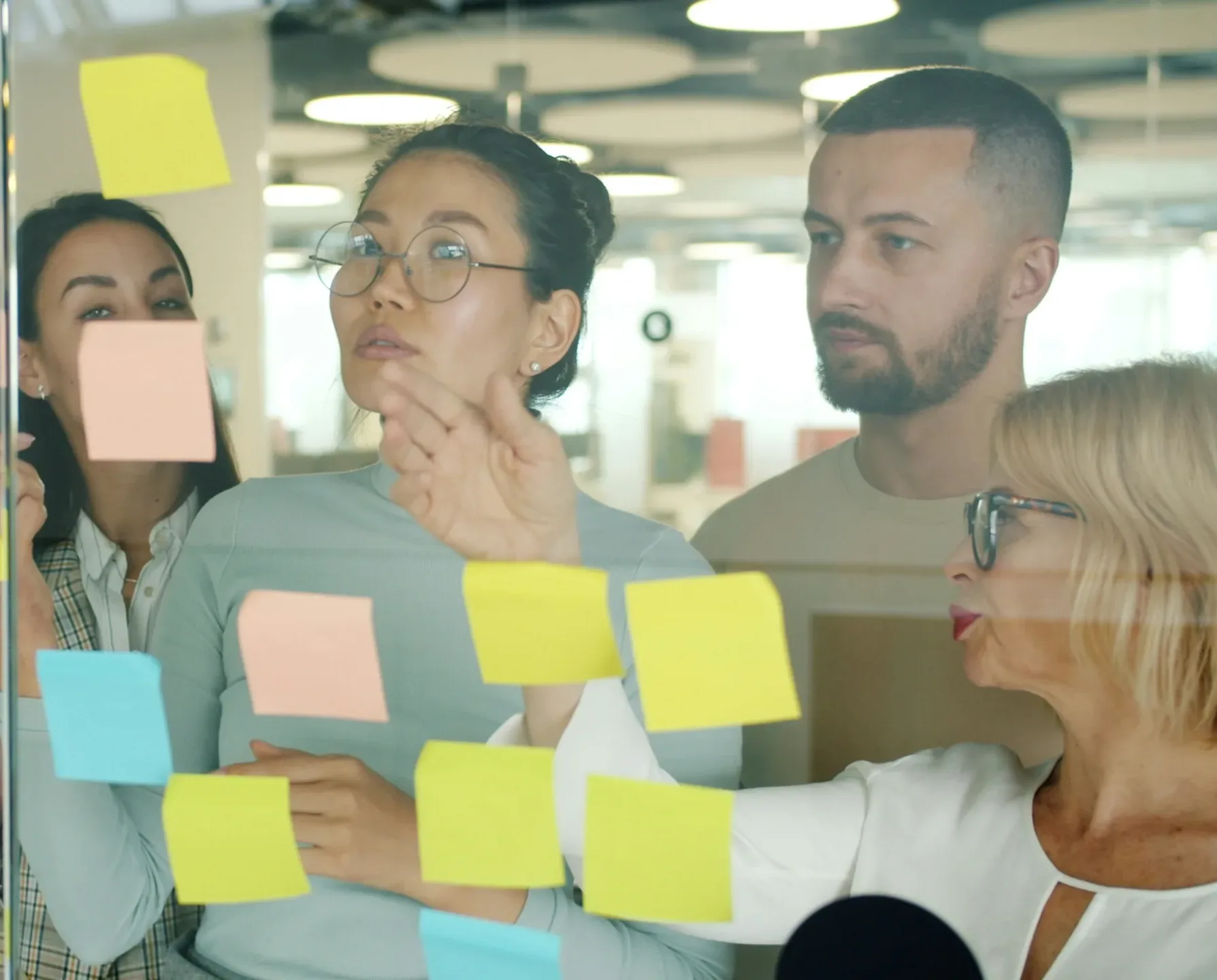The insurance industry faces mounting challenges. Market saturation has triggered cutthroat competition and slowed growth. Changing consumer behaviors and expectations demand new engagement models aligned with digital-first preferences. Legacy systems and convoluted processes obstruct responsiveness and reduce service quality.
But an antidote exists in human-centric design thinking. This framework fuses analytics, creativity, and accurate insights to solve modern challenges.
It starts by understanding customers on an emotional level before rapidly brainstorming and testing fresh solutions tailored to their unmet needs. Focusing on human requirements for security, trust, and transparency in uncertain environments like insurance reveals innovation opportunities hiding in plain sight.
By leveraging design thinking, insurers can deliver improved customer experiences, value-added offerings, and frictionless processes. Of course, organizations can’t reinvent themselves overnight. But first movers who adopt human-centric mindsets are already gaining an advantage with sustainable differentiation over laggards clinging to legacy assumptions.
Let’s look at how design thinking is already changing the insurance industry.
Understanding Design Thinking
In insurance, design thinking essentially means applying a human-centered approach to innovation and problem-solving. It requires a clear understanding of the needs, behaviors, and experiences of insurance customers, agents, and other stakeholders. This provides the insight to create more effective, user-friendly, and innovative insurance products and services.
Design thinking typically involves several key stages:
- Empathize: Engage users directly better to understand their needs, challenges, and desires. This often involves interviews, observations, and research.
- Define: Synthesize the insights gathered during the empathy stage to define the problems and opportunities clearly. This helps frame the issue—not just as a business challenge—but from the users’ perspectives.
- Ideate: Generate a wide range of creative solutions to the defined problem. This stage encourages thinking outside the box and considering solutions that might not be immediately obvious—all while leveraging the insights gained from users.
- Prototype: Develop scaled-down versions of the product or feature. In the insurance context, this could be a new digital tool, a policy structure, or a customer service process that addresses identified needs.
- Test: Iteratively test the prototypes with users, gather feedback, and refine the solution. This ensures that the final product or service meets user needs and has been improved based on actual user experiences.
In the insurance industry, design thinking can lead to major innovations that make policies more understandable. It can also make claims processes more user-friendly and customer interactions more personalized and efficient. Most importantly, design thinking helps insurers improve customer satisfaction and loyalty by aligning their products and services with evolving needs and expectations.
The Benefits of Design Thinking in a Corporate Setting
Design thinking flips old-school problem-solving on its head. Instead of consultants debating options in closed-door meetings, you open up a dialogue by observing people firsthand within their daily contexts. This empathy spotlight reveals the emotional and social realities behind why we all make choices—even when they seem illogical from the outside.
There are several studies detailing the substantial benefits of this model. According to a McKinsey study, companies practicing design thinking report a third higher revenues and 56% higher returns than those that don’t.
What’s more, Forrester says organizations that integrate design thinking have been found to cut initial design and alignment times by 75%, resulting in significant cost savings and profit increases for major projects. Beyond the quality solutions it produces, design thinking also:
- Sparks organic innovation million-dollar consultants can’t package.
- Links progress to genuine human metrics versus operational vanity metrics.
- Energizes teams by empowering them to think freely and build concepts rather than simply executing management ideas.
Consider, for instance, Blueprint Income, an online provider of personal pensions and annuities. The company leveraged design thinking concepts to solve the problem of why Millennials haven’t been saving much for retirement, effectively creating a new product targeting this generation.
Blueprint realized that upfront cost was one of the biggest roadblocks to Millennials investing in traditional insurance products like annuities. Since customers usually purchase an annuity with a single lump sum, these products were less practical for younger, cash-strapped generations.
So, Blueprint hypothesized, what if the company lowered the upfront cost? For Blueprint, looking at that one issue from a design thinking perspective helped the company transform the concept of an annuity by turning the whole model on its ear. Their solution included a smaller upfront investment—as little as $5,000–and monthly contributions of only $100. Suddenly, an underserved insurance product became relatable, understandable, and accessible to a whole new generation of customers.
The Need for Innovation in Insurance
Insurance finds itself at a crossroads. Don’t get me wrong—policies will remain essential as long as uncertainty exists. But how they’re packaged, sold, and serviced demands urgent modernizing to meet consumer expectations shaped by mobile apps and real-time data.
Insurers now confront exponential disruption, confronting challenges like:
- Commoditization and pricing pressure amid intensifying competition
- Expanding regulations requiring investments in compliance
- Legacy IT systems obstructing responsiveness and flexibility
- Data privacy and security vulnerabilities increasing cyber risk
- Customer loyalty erosion, given limited brand differentiation
In particular, the sector has struggled to keep pace with changing digital behaviors and expectations now defining consumer experiences across industries. Incumbents anchored in traditional models now risk losing ground to newcomers who are nimbler at harnessing technology to deliver consumer-centricity.
Digital Disruption
Digital disruption has rocked the entire financial services ecosystem. Consumers today expect seamless, personalized experiences akin to what Big Tech firms provide. Mobile apps, one-click transactions, and real-time analytics set new table stakes.
People want personalized coverage, pricing, and service tailored to their exact circumstances—not blunt demographic proxies. And they expect omnichannel communication integrated with other financial transactions rather than isolated once-a-year policy documents.
Yet many old-guard carriers remain anchored to legacy approaches misaligned with these modern digital needs and behaviors. Despite seeing tech trends develop for years, MetLife waited until 2018 to invest one hundred million-plus into digital capabilities like virtual medical exams and smart home tech partnerships other insurers had piloted years prior.
Compare this reactive stance to Progressive Insurance’s proactive approach. The firm began its digital transformation in the early 2000s with significant IT investments in real-time systems, integrating telematics, CRM data, and pricing analytics. This established an infrastructure to rapidly pilot and scale innovative usage-based insurance options years ahead of rivals. The company now leads the US auto insurance sector in profitability and growth.
Once-dominant brands can’t rest on monopoly laurels anymore in the face of mounting complexity. Insurers must implement structured innovation programs to continuously improve and reinvent offerings aligned with rapidly changing consumer expectations.
Applying Design Thinking to Insurance
Transforming entrenched organizations requires equal doses of creativity and discipline. That’s where human-centered design thinking models can guide sustainable innovation initiatives.
These initiatives should always kick off by engaging actual customers to uncover pain points in current policy lifecycles. Complaint logs, industry research, and operational metrics reveal quantitative benchmarks, while surveys, interviews, and ethnographic observation capture qualitative texture and context.
Next, companies must analyze findings to pinpoint priority gaps and process breakdowns that most need attention based on customer value-add or loss-reduction potential. Issues like claims assessment accuracy and application response lag times often rise to the top.
Once they’ve identified potential issues, providers can hypothesize “blue sky solutions,” imagining revolutionary possibilities if constraints evaporated.
- How could emerging technologies like automation, telematics, and augmented reality address friction points?
- What creative partnerships could enhance capabilities?
When leadership green-lights selected ideas, these should be rapidly developed into basic prototypes for concept testing rather than perfect PowerPoints. Digital mockups should utilize user response data, while physical pilots emphasize observational learning and feedback.
Once they get their hands on performance metrics, companies can modify and retest prototypes iteratively until they demonstrate adequate product-market fit. They should then craft implementation roadmaps applying “Agile” principles for incremental delivery that maintains the ability to flex amid fluid conditions.
Overcoming Barriers
Change is difficult in any industry. But insurance stands as one of the slowest to embrace new ideas. Fresh initiatives inevitably collide with entrenched mindsets and behaviors threatening the status quo. This occurs for many unsurprising reasons.
For one, tenured power structures often incentivize process adherence over creative solutions. Managers also tend to interpret new methods like design thinking as attacks on expertise rather than progression. Hierarchical companies also tend to silo knowledge and resources, restraining collaborative innovation.
Overcoming these common barriers is essential for sustaining innovation. Achieving this necessitates alignment across all organizational levels. It starts with implementing focused communication to disseminate desired cultural principles.
Introducing visible changes reinforces this effort. Examples include overhauling performance metrics, updating guidelines, and revamping workflows. Changes in office layout are another effective way to visually embed these new principles.
Augment existing teams with new profiles like user researchers, interaction modelers, and design strategists to uplift creative capacity. It can help to mix cross-disciplinary teams to combine fresh academic perspectives like behavioral economics with street-tested veterans possessing tacit operational insights.
Organizations can also poll frontline intrapreneurs across hierarchies to identify likely early adopters ready to champion experimentation. Leaders should cultivate “Champions of Change” across hierarchies to internalize messaging. They can also model how they are embracing new methodologies over old doctrines.
The Future with Design Thinking
What could the future of insurance look like for carriers embracing empathetic design thinking today? For one, the entire customer journey and backend operations would feature seamless omnichannel continuity, hyper-personalized pricing, and integrated partner ecosystems.
This would synchronize protection, risk prevention, and mitigation services. Augmented intelligence could handle certain tedious transactions while advisors focus on complex counseling. Modular plug-and-play infrastructure would readily onboard new data sources, digital channels, and specialty offerings as capabilities like IoT-enabled usage-based coverage, blockchain-enhanced claims, and computer vision-assisted assessments come online.
Tying everything together would be an open culture welcoming uncertainty as the prerequisite for creativity and resilience. Innovation tournaments would incentivize teams to pilot new concepts with customers. Enterprise idea management systems would foster bottom-up innovation.
Most importantly, progress would connect to customer sentiment ahead of old-school financial goals and standards based on historical or outdated models.
Conclusion
Design thinking has emerged as a formidable framework for human-centric innovation. Rooted in empathy, the methodology offers tools to deeply understand end users, reframe organizational challenges, and translate needs into solutions through rapid experimentation and refinement.
Within the insurance sector, design thinking can drive step-change improvements in customer and employee experiences alongside product and process upgrades. By placing people at the heart of problem-solving backed by analytics, insurers gain creative license to reimagine solutions unconstrained by legacy models.
The result? Greater customer lifetime value, improved operational efficiency, and a boost in brand preference. First movers will gain a sustained competitive advantage. Late adopters will scramble to keep pace as the competition pulls ahead.
For incumbent carriers, the window for reinvention is rapidly closing, but design thinking offers a clear pathway to renewal. As daunting as disruption seems, design thinking provides a path forward by reframing challenges into opportunities.





